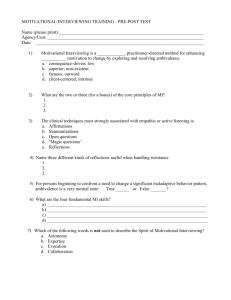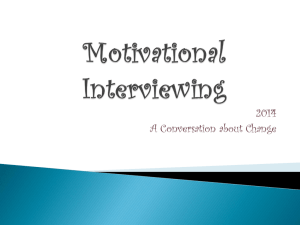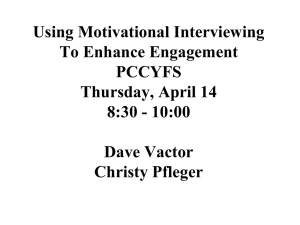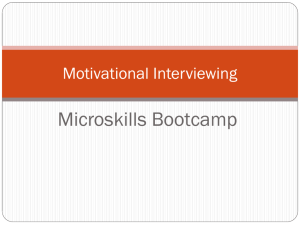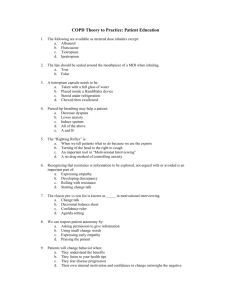MOTIVATIONAL INTERVIEWING 16 Annual Primary Care Conference
advertisement
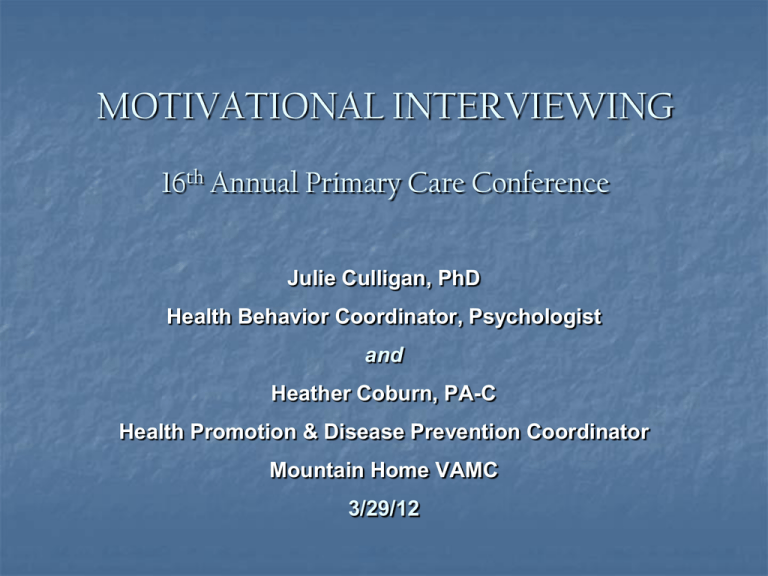
MOTIVATIONAL INTERVIEWING 16th Annual Primary Care Conference Julie Culligan, PhD Health Behavior Coordinator, Psychologist and Heather Coburn, PA-C Health Promotion & Disease Prevention Coordinator Mountain Home VAMC 3/29/12 MI Philosophy "People are generally better persuaded by the reasons which they have themselves discovered than by those which have come in to the mind of others.” ~ 2 Blaise Pascal, French mathematician, physicist and religious philosopher Facilitating Behavior Change What makes behavior change so hard? It works for us “Habit” It often involves multiple behaviors Knowledge about how to change isn’t always enough People are creatures of habit Health consequences are often delayed Busy lifestyles require us to make time for self care 3 Motivational Interviewing “A person-centered, goal-oriented approach for facilitating change through exploring and resolving ambivalence.“ (Miller & Rollnick, 2006) A clinical “style;” a “way of being with people” (Miller & Rollnick, 2002; Rollnick & Miller, 1995) 4 Motivational Interviewing: Based on Theory Conceptualized according to stage model of change (Prochaska & DiClemente, 1982) Not everyone engages in treatment at the same stage of readiness Different type of approach may be utilized for individuals at different stages Transtheoretical Model: Stages of Change A STAGE MODEL OF THE PROCESS OF CHANGE Pre-Contemplation Contemplation Determination Relapse Maintenance Permanent Exit Action The Goal of MI The goal of MI is to facilitate: Fully informed, Deeply thought out, Internally motivated choices, Not to change behavior….. Resnicow, et al., 2002 7 Traditional vs. Motivational The “Doctor”: Places the importance on the behavior change Controls the interaction May direct/select the goals the patient should achieve 8 The “patient”: Determines the importance of the behavior change Is listened to, shares concerns and needs Is supported in decisions about change and goals Empathic Style of MI and Brief Interventions The key element in brief interventions is empathy Research on empathy and clinical outcomes: Strongest predictor of outcomes Not accounted for by demographics Not accounted for by treatment type Patient Focus MI supports the patient in articulating 10 How personally important this change (e.g., dietary) is, as opposed to how important we think it is What stands in the way of making this change (time, money, cultural factors, emotions, etc.) Changes that might work in their life How to increase the chances of success Learning MI Techniques Listening Skills Spirit Spirit of Motivational Interviewing Evocative Honoring Autonomy (vs. Authority) – (vs. Educational) – patient is responsible for change. (“What would you gain if you changed your drinking?”) vs. implanting the right idea (“You really need to stop drinking.”) Allow the freedom not to change. (“How ready are you to change?) vs. push for commitment (“If you delay getting sober, you could die.”) Collaborative (vs. Confrontational) – Work in Partnership. (“How about we discuss some options together” vs. “I would urge you to quit drinking.”) 12 The Spirit of MI Motivation for change is elicited from within the patient, not imposed from outside The patient must articulate reasons for change The patient is the one responsible to decide Direct persuasion is ineffective The clinician should steer the conversation to focus on change Ambivalence Interesting, natural, human, understandable Not unique to characterological problems Not indicative of defense (denial) “I want to but I don’t want to” Unhelpful to think of people as “unmotivated” SPIRIT OF MI Ambivalence APPRECIATE AMBIVALENCE HONOR, EMBRACE, EXPLORE AMBIVALENCE. It’s the core. Many brief (and single session) therapies work by focusing on this ambivalence, not on skills (people frequently have the skills) The RIGHTING Reflex “This person SHOULD want to change.” NOW is the right time to change. A TOUGH/clear/honest approach is best. Patient should follow my EXPERT ADVICE. If patient doesn’t change, the session FAILED. There’s nothing we can do for the “unmotivated.” Rather than the Righting Reflex, Understand Ambivalence Reflective listening Acceptance; non-judgmental; no blaming Helps patients to feel understood Provides comfort to patient (makes change easier) Acceptance ≠ Agreement Ambivalence = normal (not pathological) Communication is a Dance Not a Tug of War Evaluate the Pros and Cons Reducing/Giving up Tobacco Pros (Good Things) I can still smoke with I friends Smoking the Same It helps me deal with my stress Feel better Making Changes in Smoking Have more energy Have more money Cons (Downsides) It’s hard to breathe It’s a fire hazard It’s bad for my health It’s expensive I wouldn’t be able to hang out with my friends who smoke I wouldn’t have a way to deal with my problems Evaluate the Pros and Cons Increasing Medication Adherence Pros (Good Things) I can still smoke with I friends Stay the Same, i.e., Non-Adherent It helps me deal with my stress Feel better Making Changes, i.e., Adherent Have more energy Have more money Cons (Downsides) It’s hard to breathe It’s a fire hazard It’s bad for my health It’s expensive I wouldn’t be able to hang out with my friends who smoke I wouldn’t have a way to deal with my problems Four Key Principles of MI Express empathy Develop discrepancy Roll with resistance Support self-efficacy (1) Express Empathy Reflective listening Acceptance; non-judgmental; no blaming Helps patients to feel understood Provides comfort to patient (makes change easier) Acceptance ≠ Agreement Ambivalence = normal (not pathological) (2) Develop Discrepancy Change is motivated by perceived discrepancy between present behavior and personal goals/values Discrepancy = importance of change for patient Amplify the discrepancy to move patient from the status quo Elicit discrepancy from the patient – they should make the argument for change (3) Roll with Resistance Argument often pushes person in the opposite direction Resistance is a call for the clinician to change, not the patient Questions and problems should be reflected back to the patient, not “solved” by the clinician (4) Support Self-Efficacy Be aware of your own beliefs about a patient’s ability to change (self-fulfilling prophecy) Enhance patient’s self-belief about his or her capability to make a change Be genuine What People say about Change predicts Behavior Change Self-perception theory 27 Core MI Strategies Four Early Strategies; OARS Open Questions Affirming Reflective Listening Summarizing 28 Elicit Positive “Change Talk” Open-Ended Questions Disarms resistance Creates momentum Avoids arguments You want them engaged and exploring – with you gently steering Open Questions to Promote Change Disadvantages of the Status Quo How do you feel about your weight? Advantages of Change What would the benefits be for you, if you were to quit smoking ? Optimism for Change What makes you feel that now is a good time to try something different? Intention to Change 30 What would you like to see happen? How might things be different for you, if you did make a change? Affirmation Genuinely highlight patients’ strengths Antidotes to demoralization Appreciative of partial success (ex. Focus on success with quitting smoking for 2 years in past) Appreciates their honesty regarding ambivalence Reflective Listening – The Foundation of MI “MINI-SUMMARIES” used strategically to lower resistance Used to highlight patient statements favoring change (“Change Talk”) A way of thinking, Difficult to learn Powerful for increasing readiness Expert ratio 2 reflections for every question vs. Novice ratio .5 reflections for every question Handy Reflections Double-Sided (reflects both sides of ambivalence) – takes the clinician out of the equation – puts the ambivalence in their own lap So on the one hand, you like how alcohol makes you feel and at the same time, you worry about your Hepatitis. Amplified – can go in either direction Undershoots so patient might elaborate, “You’re a LITTLE confused…” Overshoots so patient can back down, “So you don’t EVER intend to cut down…” Handy Reflections Shifting Focus – shift patient’s concern away from a potential stumbling block – around barriers rather than over them c: “Okay, maybe I’ve got some problems with drinking, but I’m not alcoholic.” Argument with a Twist – offer initial agreement, but with a slight twist or change of direction Summarizing Helps the other person: Recall and reflect upon the conversation Think of new ideas Understand the importance of these issues Plan next steps Feel more confident, instill hope 35 Importance and Confidence 36 Importance: lets you know how important this issue(s) is to the patient, in the grand scheme of other important values in their life Confidence: lets you know how able the patient feels he/she is to make specific changes towards his/her goal(s) Readiness Indicators Assessing Importance and Confidence Importance How important is it to you to ____________? On a scale of 0 to 10, with 0 being not important at all & 10 being very important… 0 1 Not a all 2 3 4 5 6 Somewhat 7 8 9 Very 10 Confidence How confident are you that you could _____________, if you decided to? On a scale of 0 to 10, with 0 being not confident at all & 10 being very confident? 0 1 Not at all 37 2 3 4 5 6 Somewhat 7 8 9 10 Very Evaluating Importance/Confidence • “What made you answer with a (number patient gave) and not a zero?” • “What would it take for you to move from a (number patient gave) to a (slightly higher number)?” 38 Setting Goals Specific Measurable Achievable/Action Oriented Realistic 39 Timely Let’s see how we pull this together… Resources www.motivationalinterview.org Clinical issues Background Special Populations Group Approaches The Library Abstracts Bibliography MINUET Newsletter Links Training Upcoming Training MINT Trainers Training Videos 41 http://vaww.chce.research.va.gov/apps/bmiforsuv/default.html 42 MI Books Miller, WR & Rollnick, S (1991). Motivational interviewing: Preparing people to change addictive behavior. New York: Guilford Press. Miller, WR & Rollnick, S (2002). Motivational interviewing: Preparing people for change (2nd ed.). New York: Guilford Press. Arkowitz, H, Westra, HA, Miller, WR, Rollnick, S (Eds.) (2008). Motivational interviewing in the treatment of psychological problems. New York: Guilford Press. Rollnick, S, Miller, WR & Butler, CC (2008). Motivational interviewing in health care. New York: Guilford Press. 43 MI Articles 44 Britt, E, Hudson, SM, & Blampied, NM. (2004). Motivational interviewing in health care settings. Education and Counseling, 53, 147-155. Emmons, KM, & Rollnick, S. (2001). Motivational interviewing in health care settings. American Journal of Preventive Medicine, 20, 68-74. Greaves C, Middlebrooke A, O’Loughlin L, Holland S, Piper J, Steele A, Gale T, Hammerton F, Daly M (2008). Motivational interviewing for modifying diabetes risk: a randomized controlled trial. British Journal of General Practice, 58(553), 535-40. Hecht, J, et al. (2005). Motivational Interviewing in community-based research: Experiences from the field. Annals of Behavioral Medicine, 29 Special Supplement, 29-34. Resnicow, K, et al. (2001). Motivational interviewing in health promotion: It sounds like something is changing. Health Psychology, 21, 444-451. Soria R, Legido A, Escolano C, and Yeste A (2006). A randomized controlled trial of motivational interviewing for smoking cessation. Br J Gen Prac, 56(531), 768-774. Moyers T, Martino S (2006). “What’s important in my life” The personal goals and values card sorting task for individuals with schizophrenia. Zygmunt A, Olfson M, Boyer A, Mechanic d (2002). Interventions to improve medication adherence in schizophrenia. American Journal of Psychiatry. Possidente C, Bucci K, McClain W (2005). Motivational interviewing: A tool to improve medication adherence? American Journal of Health-System Pharmacy, 62(12) 1311-1314. Swaminath G (2007). You can lead a horse to water… Indian Journal of Psychiatry, 49(4), 228230. Cole S, Bogenschutz M, Hungerford D (2011). Motivational Interviewing and Psychiatry: Use in addiction treatment, risky drinking and routine practice. FOCUS, 9:42-54. www.ComprehensiveMI.com
